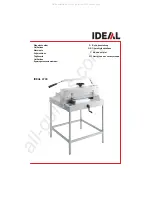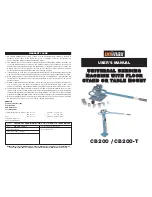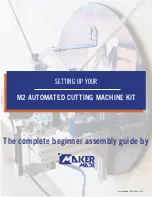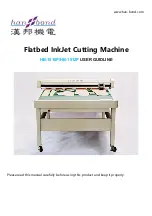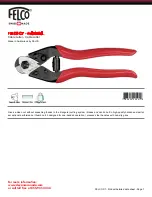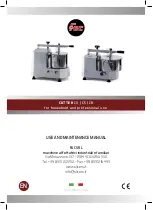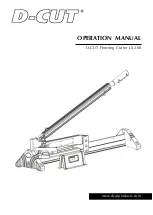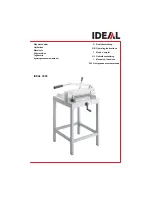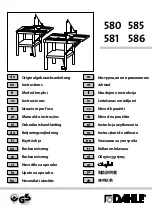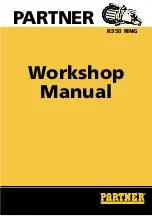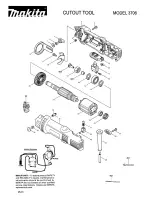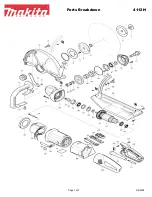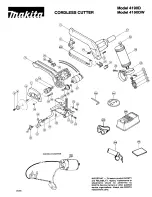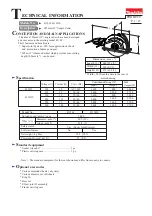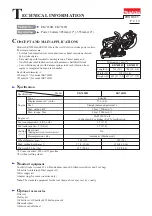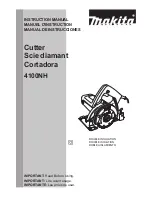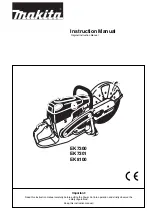
Pre-Operation
(Cont.)
How to lubricate tool:
1. Disconnect the tool from air supply if
connected.
2. Turn the tool with the air swivel
pointing upward.
3. With the trigger pulled, add a
teaspoon of oil to the air inlet port.
4. Release trigger and connect the air
hose. Cover exhaust port with a rag,
then run tool for approximately 20
seconds.
5. Wipe the tool clean.
Cover tool exhaust
port with a rag and
then apply air pressure. Failure to
cover exhaust port will allow oil mist
to be sprayed from tool, which might
cause damage to work piece and cause
personal injury.
Operation
Follow the previous safety instructions.
Check for proper system setup and
connection of the tool.
INSTRUCTIONS ON USING CUTOUT
BITS
Do not use 1/4”
cutout bits with this
tool. The cutting flutes on 1/4” cutout bits
are too aggressive, making this tool hard
to control.
1. With air hose disconnected, install
the cutting bit into the tool by:
A. With the shaft lock button
depressed loosen the collet nut by
turning counter clockwise (CCW)
with a 5/8” wrench. A couple of
rotations CCW are all that is
needed.
B. Insert the bit into the collet
leaving 1/16” to 1/8” of smooth
shank visible above the collet.
NOTE: The bit flutes are sharp,
handle with care.
C. After properly placing the bit into
the collet, depress the shaft lock
button and simultaneously tighten
!
CAUTION
!
WARNING
3
Operating Instructions
the collet nut in a clockwise (CW)
direction. Tighten collet nut by
hand first, then use a wrench until
bit is held securely.
If the bit flutes are
inside the collet
when the collet nut is tightened, the
bit may break.
If the cutting bit is
removed from the
tool for storage, do not tighten the
collet nut. Tightening the collet nut on
an empty collet will cause the collet
hole to become smaller, preventing
you from inserting a bit in the future.
2. Adjust the depth guide. Use the
depth guide to adjust the depth of
the cut. The depth guide assembly
consists of the depth guide, locking
knob and bracket. Loosen the
locking knob by turning counter
clockwise (CCW) enough to enable
the depth guide to slide up or down
to the desired depth of your cut and
retighten the locking knob by
turning clockwise (CW). It is best to
allow the cutting bit to be 1/16”
greater than the material you are
cutting.
3. Check that all parts are tight and
safety equipment is in place before
turning on the tool.
4. Attach the air hose, turn on the tool
while holding tool firmly and apply
to work-piece by inserting the bit
into the material at a 45-degree
angle.
5. Slowly bring it to a 90-degree angle
to begin the cut. The guide should
be firmly touching the work-surface.
For most materials, slide the tool in a
clockwise direction with a slow and
steady pressure to make the cut.
!
CAUTION
!
CAUTION
NOTE: When using a bit and cutting
drywall, use a counter clockwise (CCW)
rotation.
6. After completing your cut, turn off
the tool and carefully remove it from
the work surface.
NOTE: Because of the rotating cutting
action of the bit, there will be a slight
pull when cutting. The slower you cut,
the more control you have. Excessive
force will cause excessive heat and may
shorten the life of the bit.
NOTE: When cutting on a vertical
surface, avoid ending your cut at the
bottom of the hole. If possible, start
and end your cut at the top so scrap
material will not drop onto the
rotating bit.
INSTRUCTIONS ON USING GRINDING
STONES, HIGH-SPEED CUTTERS AND
BURRS
NOTE: This tool is shipped with a 1/8”
collet installed in the tool. If 1/4” bits
are to be used then the 1/8” collet
needs to be removed from the tool.
The 1/8” collet can be removed by
removing the collet nut and pulling out
the 1/8” collet.
Disconnect the air hose.
1. Remove any accessory that is in the
tool.
2. Insert the accessory fully into the
collet, and then pull out
approximately 1/16” before
tightening collet nut.
3. The depth guide may or may not be
used depending on your application.
4. Check that all parts are tight and
safety equipment is in place before
turning on the tool.
5. Attach the air hose and begin
cutting, grinding or sanding.
NOTE: Do not try to use accessories
with 1/32”, 1/16”, or 3/32” diameter
shanks. Some 1/8” shank high-speed
router bits have large cutting edges
and should not be used in this tool.
Do not use wire
brushes, bristle
brushes or polishing wheels in this
tool. These accessories are designed to
work on tools with a low RPM setting.
When using steel
saws, high speed
cutters or tungsten carbide cutters,
always have the work securely
clamped. Never attempt to hold the
!
WARNING
!
CAUTION
Shank
Flutes
Cutting
Surface
Figure 2
Figure 3 - Bits can cut material up to
1” thick
www.chpower.com
Manual de Instrucciones
Funcionamiento
(Continuación)
seguridad esté colocado en su lugar
antes de encender la herramienta.
4. Conecte la manguera de aire, encienda
la herramienta mientras la sostiene
firmemente y la aplica a la pieza de
trabajo introduciendo la mecha dentro
del material en un ángulo de 45º.
5. Lentamente lleve la herramienta a
un ángulo de 90 grados para
comenzar el corte. La guía debe estar
tocando firmemente la superficie de
trabajo. Para la mayoría de los
materiales, deslice la herramienta en
dirección a las agujas del reloj con
una presión lenta y constante para
realizar el corte.
NOTA: Para paredes de yeso (usando
una punta de corte para pared de yeso)
deslice la herramienta en la dirección
contraria a las agujas del reloj.
6. Después de completar el corte,
apague la herramienta y retírela
cuidadosamente de la superficie de
trabajo.
NOTA: Debido a la acción rotatoria de
corte de la punta, usted sentirá que la
herramienta tira levemente cuando
está cortando. Cuanto más lento corte,
más control tendrá. La fuerza excesiva
causará un calor excesivo y puede
reducir la duración de la punta.
NOTA: Cuando corte sobre una
superficie vertical, evite terminar su
corte en el fondo de un orificio Si es
posible, comience y finalice su corte en
la parte superior para que el material
de desecho no caiga sobre la punta
rotatoria.
INSTRUCCIONES PARA EL USO DE
PIEDRAS MOLADORAS,
CORTADORAS DE ALTA VELOCIDAD
Y DESBARBADORAS
NOTA: Esta herramienta se envía con
una boquilla de 1/8” (3,2 mm) instalada
en la herramienta. Si se van a usar
mechas de 1/4” (6,4 mm) entonces se
debe quitar la boquilla de 1/8”. La
boquilla de 1/8” (3,2 mm) se puede
quitar sacando la tuerca de la boquilla
y tirando la boquilla de 1/8” (3,2 mm)
hacia afuera.
Desconecte la manguera de aire.
1. Retire cualquier accesorio que se
encuentre en la herramienta.
2. Introduzca el accesorio totalmente
dentro de la boquilla y luego tire
hacia afuera aproximadamente 1/16”
(1,6 mm) antes de apretar la tuerca
de la boquilla.
3. La guía de profundidad se puede
usar o no dependiendo de su
aplicación.
4. Compruebe que todas las piezas
estén apretadas y que el equipo de
seguridad esté colocado en su lugar
antes de encender la herramienta.
5. Conecte la manguera de aire y
comience a cortar, amolar o lijar.
NOTA: No intente usar accesorios con
espigas de un diámetro de 1/32" (0,82
mm), 1/16" (1,6 mm), o 3/32" (2,38).
Algunas punta de rebajado de alta
velocidad con espigas de 1/8" (3,2 mm)
tienen grandes bordes de corte y no se
deben usar en esta herramienta.
No use
cepillos
de alambre, cepillos de cerdas o ruedas
de pulido en esta herramienta. Estos
accesorios están diseñados para
funcionar en herramientas con valores
de s
-1
bajos.
Cuando
use
sierras de acero, cortadoras de alta
velocidad o cortadoras de carburo de
tungsteno, siempre fije el trabajo con
grapas. Nunca intente sostener el
trabajo con una mano mientras usa
cualquiera de estos accesorios. El
motivo es que estos accesorios pueden
agarrarse si se inclinan un poco en la
ranura y podrían contragolpear o
quebrarse provocando la pérdida del
control de la herramienta, y dando
como resultado graves lesiones
personales. Su segunda mano se debe
usar para estabilizar y guiar la mano
que sostiene a la herramienta.
!
AVERTISSEMENT
!
PRECAUCION
Almacenamiento
La herramienta neumática debe
lubricarse antes de almacenarla. Un
motor neumático nunca será lubricado
con mucho frecuencia.
Servicio Técnico
Para obetener información acerca del
funcionamiento o reparación de este
producto, sírvase llamar al 1-800-543-
6400.
Información Sobre Piezas de
Repuesto
Para obtener información de como
obtener piezas de repuesto en Estados
Unidos, sírvase llamar al 1-800-543-
6400. En el exterior, comuníquese con
el distribuidor de productos Campbell
Hausfeld más cercano a su domicilio.
Suministre la siguiente información:
• Número del modelo
• Código estampado
• Número de pieza y descripción
Puede escribirnos a:
Campbell Hausfeld
Attn: Parts Department
100 Production Drive
Harrison, Ohio 45030 U.S.A.
14 Sp

















